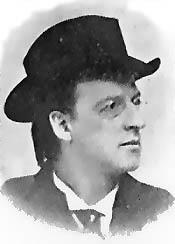|
AMBRIDGE REPRISE
|
Tip-Toe Thru' The Tulips With Me.
|
|
Al Durbin, Song title (1939)
|

The town formation and industrialization started on April 11, 1894. The Harmony Society’s Board of Elders and the 18 remaining members voted to transfer all Society land to a newly formed holding entity called The Union Company.
John Duss (pictured left) was named to head the operation, dispose of the assets, and distribute the proceeds to the survivors. His task was complicated by the appearance of promoters, confidence men and women, attorneys, Judges, opportunists, and an assortment of claimants who often grossly overestimated the worth of the holdings.
Shortly afterwards, A P Roberts Co. acquired Berlin Iron's property and wanted another 70 acres. During negotiations, questions about the site's suitability emerged. The land was on the flood plain of the Big Sewickley Creek where it entered the Ohio River and was inundated when the river flooded.
J. T. Brooks again assisted with a plan to raise the ground level eight or ten feet. His railroad would transport waste blast furnace slag from the Pittsburgh steel mills and dump it on the site.
In December 1900, A P Roberts Co. bought two options for $10,000. One was for a factory site and the other for residential uses. The options were for the purchase 200 acres at $1000 per acre.
Two years later, the American Bridge Company assimilated A P Roberts Co. A. J. Major, president of American Bridge, signed contracts for 105 acres for the factory and 25 acres for the office building. They paid $20,000 and $2500 to the Union Company.
Production could not even begin until they acquired or built a large manufacturing facility, found men to work in the mill, build residences for their families, and develop a local support system to supply life's necessities.
Charles Kristufek was a recent Czech immigrant living in McKees Rocks, PA when he was recruited by American Bridge to represent them in recruiting labor and building the town's support system. More about him later.
James E. McKee came to Economy early in 1903 as a representative of the Real Estate Trust Co. of Pittsburgh, the selling agent for the Ambridge Land Company. The trust had about one thousand residential building lots. These were the first of the Society's holdings to be marketed.
James A. Huston, district manager of the American Bridge Co., was also president of the Liberty Land Company, which bought 2523 acres of the Society's acreage in Beaver County and 20 acres in Allegheny. For their land, the Society received not cash, but interest bearing bonds with a face value of $2,000,000. Liberty Land hoped to benefit from a speculative market and paid about three times the value of the property.
The speculation was fueled by reports that one Elbert H. Gary was considering a major industrial development and the Ambridge site was high on the list.
Most of the bonds were used by Duss to liquidate shares owed to fomer members and to pay attorneys fees generated by almost continuous litigation from mostly unsubstantiated outside claims.
At this point, John Duss felt the Harmonite community was dissolved and his tasks completed. He was wrong in a big way.
The land rush was over by 1905. Judge Gary ignored Ambridge and built his town and steel works on the southern shore of Lake Michigan. Local development stagnated and the price of Liberty Land stock and bonds dropped with the declining land values.
Rather than let the holdings go into legal default, C. A. Dickson, the son of a former Harmonite trustee, and John Duss joined to purchase (using his own holdings) the Liberty stock. They worked with K. R. Wagner and C. Roy Kerr of the Valley Realty Company to plot and sell industrial and residential land and to recruit business.
Another ten years would pass before the Harmonite land was sold and Duss could declare that 25 years of hard work and frustration had ended.
Photo credit: Centennial Program